Exit Project in International Law : Research Proposal
Added on 2020-05-28
37 Pages10226 Words149 Views
Running head: EXIT PROJECT IN INTERNATIONAL LAWExit Project in International LawName of the StudentName of the UniversityAuthor Note
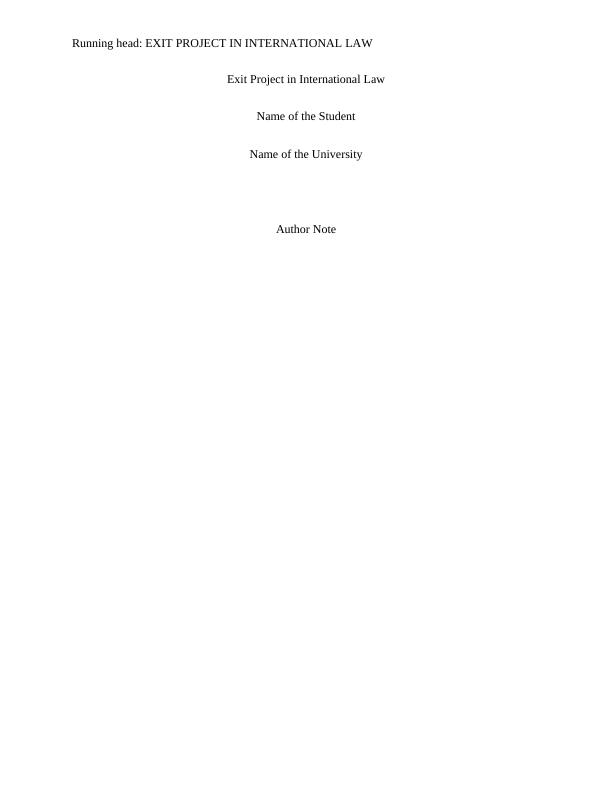
1EXIT PROJECT IN INTERNATIONAL LAWTable of ContentsProposal...........................................................................................................................................21.0.Introduction...........................................................................................................................21.1.Background of the study.......................................................................................................31.2.Rationale of the Research.....................................................................................................61.3.Aims and objective of this Research....................................................................................81.4.Research Questions...............................................................................................................82.0.Work methodology...............................................................................................................93.0.Main discussions.................................................................................................................113.2.Issues experienced by refugees.......................................................................................213.3.Statute of the International Criminal Court........................................................................264.0.Conclusion..........................................................................................................................265.0.Recommendation................................................................................................................28
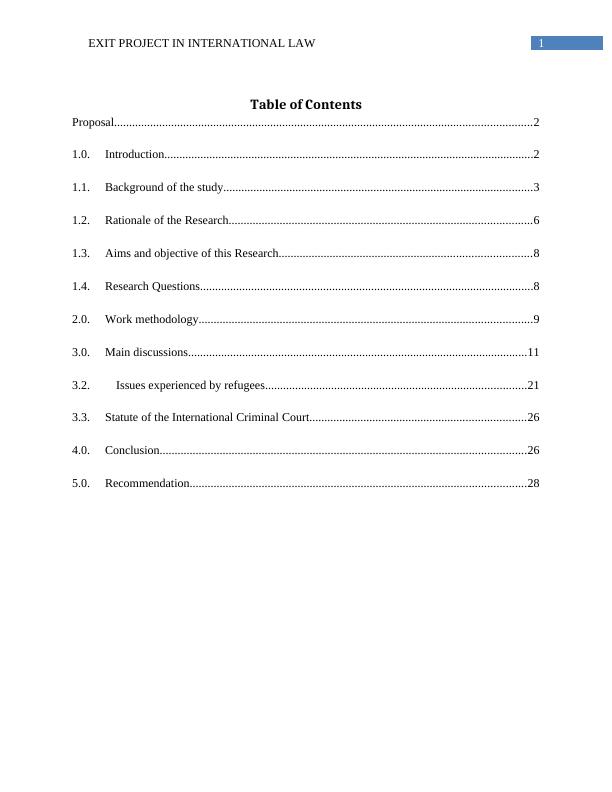
2EXIT PROJECT IN INTERNATIONAL LAWProposal1.0.IntroductionThis research proposal entails the international responsibility and cooperation incombating significant challenges in several countries and regions pertaining to refugees, asylumseekers and migrants. It further discusses about the principles and legal protection that isaccorded to the humans by the international law for ensuring protection of their rights. Theresearch proposal describes the historical situations with the help of cases, in which states haveworked together for creating and developing cooperative responses to the refugee movements(Smith 2018). Individuals and groups fleeing persecution for decades and the states have been strivingto ensure that the individuals and group are safeguarded. The modern refugee, like theInternational Human Rights Law has originated because of World War II as well as therefugee crisis of the inter-war years that took place in the preceding years. According to Article14(1) of the Universal Declaration of Human Rights (UDHR) that was enforced in 1948assures the right of the refugees and asylum seekers to enjoy and seek asylum in other countries.The regional human rights instruments have expanded this right by assuring the right to seekand enjoy asylum in other countries (Shelton 2015). Regional human rights instruments, statelegislations and International conventions like American Convention on Human Rights underarticle 22(7) and the African [Banjul] Charter on Human and People’s Rights under article12(3) have expanded on the right that guarantees right to seek and be asylum in a alien territory.

3EXIT PROJECT IN INTERNATIONAL LAWThe International Convention on refugee law that governs the refugee law includes the1951 Convention relating to the Status of Refugees [1951],Convention and its OptionalProtocol relating to the Status of Refugees [1967 Optional Protocol]. The 1951 Conventionprovides the definition of refugee as well as it defines the rights to which the immigrants grantedwith refugee status are entitled. However, there is no convention for the Internally Displacedpersons equivalent to the Refugee Convention 1951. Nevertheless, once persons are displacedunder several bodies of law, the international law safeguards such persons from displacement(Donnelly, Jack and Daniel 2017). 1.1.Background of the studyThe problem associated with the internally displaced persons and the refugees has becomeone of the most intricate global concerns in this contemporary era. The United Nations persists toascertain more effective and appropriate ways to assist and safeguard the vulnerable groups.While some suggest enhancing the level of coordination cooperation among relief agencies,others consider that the gaps between the international legislation should be filled to effectivelyovercome the issues pertaining to refugees, asylum seekers and internally displaced persons inthe global arena (Forsythe 2017). However, majority of the state parties to the UN agree with thefact that to resolve this global problem, it is imperative to introduce approaches that are bothcomprehensive and effective in addressing every aspect of the issue. These include the causes ofsuch mass departure to the expansion of the responses that are mandatory to deal with variousrefugee situations from repatriation and emergencies. There are certain facts, which are beyond any dispute. For instance, it is possible to preventcertain mass departures but it should be understood that such departures are not voluntary. In

4EXIT PROJECT IN INTERNATIONAL LAWother words, people do not become refugee by choice as being a refugee implies being an alienwho is dependent on others for their basic needs that is essential for their survival such as food,shelter and clothing. Since the inception of the United Nations, the UN has strived to safeguardthe refugees all over the world. There were approximately 1 million refugees under the mandateof United Nations High Commissioner for Refugees (UNHCR) in the year 1951 when UNHCRwas established. However, there has been an incline in the refugee rate, up to 17.5 million alongwith an increase in displaced persons to 25 million approximately. In the year 1951, majority of the refugees were Europeans whereas majority of the refugeestoday come from Asia and Africa. At present, the refugee movements have rapidly taken theform of mass departure instead of individual migration and the refugees mostly include womenand children. Although the primary reason for mass exodus is considered to be the fear ofpersecution that has been defined under the 1951 Convention but such reasons have multipliedand now include extreme poverty as well as natural or ecological disasters as reasons for suchmass departure of the refugees (Horowitz 2017). This refers to the victims who fled for theapprehension of being persecuted on the grounds of belief, ethnic group, race and associationwith any particular political or communal group or supporting any social or political opinion. The United Nations have also been equally alarmed about the recent incline in the rate ofinternally displaced persons all over the world. The ‘internally displaced persons’ refer to thosepersons who are compelled to leave their residence but stay within the province of theirrespective countries. Since these persons stay within the territory of their respective countries,these persons are not considered within the existing system of refugee protection. Thecircumstances where persons are internally displaced within their respective country generallymostly arise in developing countries and they mainly comprise women and children. Further, in
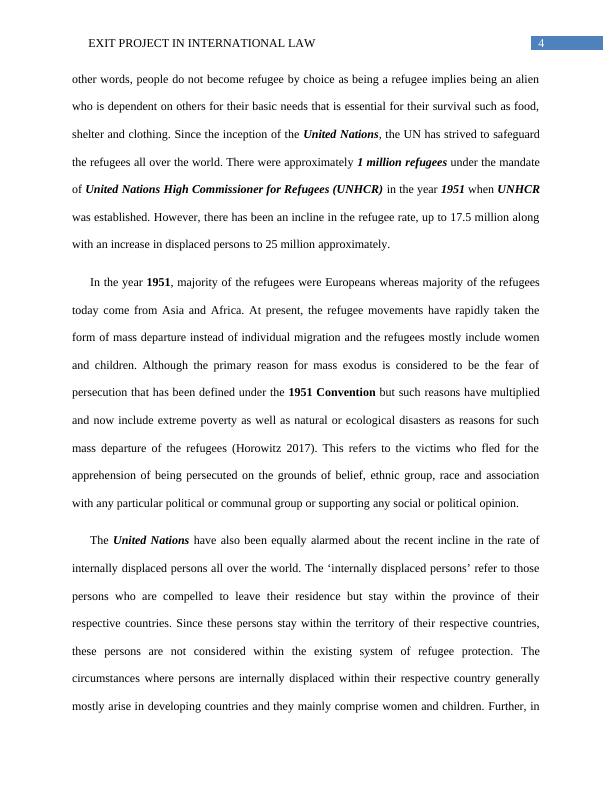
5EXIT PROJECT IN INTERNATIONAL LAWsome of the developing countries, the internally displace persons make up almost 10 percent ofthe population of the country. Although the refugee situation and the problems associated, withInternally Displaced persons have become a growing concern but such situation demonstratesthe dependence of the international community. It exemplifies how issues in one country canhave an immediate consequence for the other countries, also reflects the interdependenceregarding the issues (Goodhart 2016). There is a comprehensible relationship between the issue of human rights and the refugeeproblems. This is evident from the fact that the infringement of human rights is one of thesignificant reasons for mass departure but it excludes the option of voluntary repatriation rule aslong as such human rights are violated resulting in mass exodus. The contravention of humanrights of the minorities and the increase in the ethnic conflicts forms the source of both internaldisplacements and mass departure. The other significant cause for the refugees and the internallydisplaced persons is the disregard for the minimum rights for the refugees and a common factorthat forms a relationship between the two issues. While seeking asylum, an increasing number of persons seeking the same have to experiencerestrictive measures that prevents them to have admission to safe territories. In some cases,refugees ad asylum seekers are either forcefully returned or retained to areas where theirsecurity, lives and liberty are at risk. This is because the armed groups of the country they seekasylum from or apply to obtain the status of a refugee attack some of them or they are forcefullyrecruited into armed forces where they are compelled to take part in civil conflicts. Majority ofthe refugees and the asylum seekers are subjected to racial discrimination (Harvey 2015).
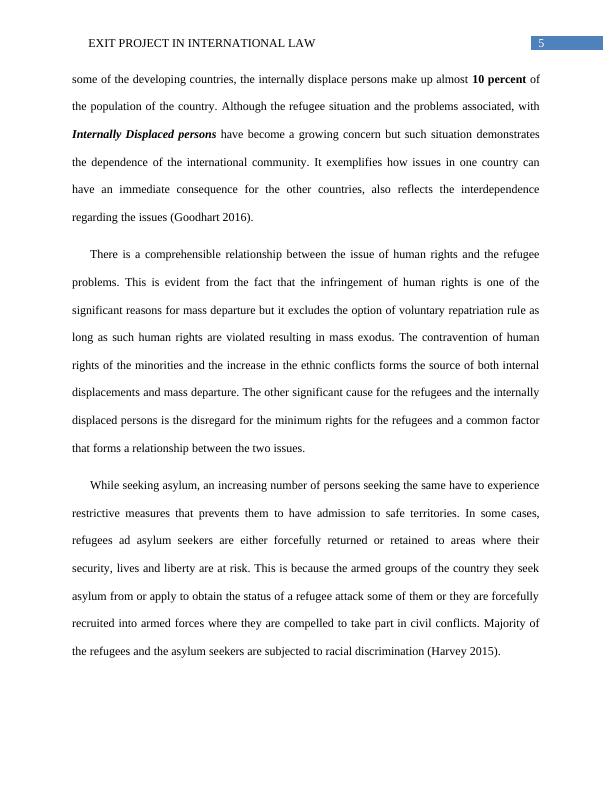
6EXIT PROJECT IN INTERNATIONAL LAWIt is imperative that the rights of the refugees are respected before and during and after theasylum seekers are granted the status of a refugee. In order to deter and resolve all the issuesassociated with refugees and asylum seekers, it is pertinent to respect the rights and dignity ofthe refugees. As asserted by the United Nations High Commissioner for Refugees, the issuesassociated with refugees should be regarded as a assessment of their commitment to humanrights for all the governments and the people. 1.2.Rationale of the ResearchThe rationale of the research is to understand the various international laws that havebeen formulated to safeguard the rights of the refugees, asylum seekers and the internallydisplaced persons. There is a relationship between human rights and the refugees where theviolation of human rights have been identified to be a fundamental reason for mass exodustaking place all over the world. Therefore, the research aims at discussing the variousinternational legal provisions that intends to safeguards the human rights of the refugees and theinternally displaced persons ensuring they are not deprived of their human rights. The protectionof the human rights accorded to the refugees and the internally displaced by international law isevident from the cooperation and collaboration of the international communities with respect torefugee crisis that occurred in several parts of the world (Nanda 2016). The UNHCR and the 1951 Refugee Convention is the main statutory framework thatextends protection and assists the refugees. The human rights law and the international humanrights law safeguards the refugees from situation, which gives rise to armed conflict. Althoughthe civilian refugees in States who are engaged in armed conflict are safeguarded under theprovisions of the International Human Rights Law, they are also entitled to receive special
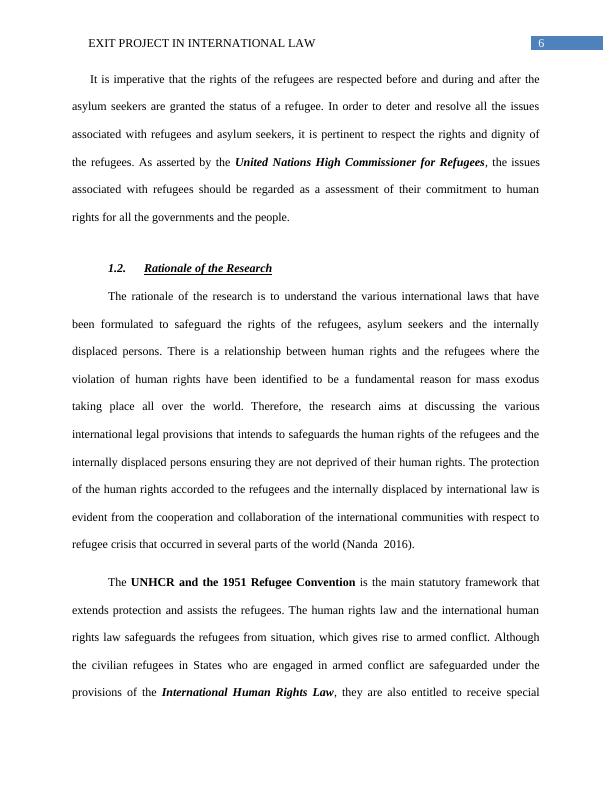
7EXIT PROJECT IN INTERNATIONAL LAWprotection under the Additional Protocol I and the Fourth Geneva Convention. Theadditional protection that these refugees are entitled to identifies the weakness of the refugees asaliens who are compelled to take part in the armed conflict. There is no international convention for the Internally Displaced persons like thelegislative framework of 1951 Refugee Convention. However, the international human rightslaw safeguard people being internally displaced as civilians unless they take part in conflict. Theinternational human rights play a significant role in deterring displacement altogether. Theinternational provisions prevent displacement of people unless there is a mandatory requirementto displace persons for military purposes or for safeguarding the civilians themselves. However,a systematic or a widespread policy for displacement of civilians without any proper justified orvalid reasons shall amount to a crime against the humanity. Several rules of the international human rights law aims at safeguarding the civilianpopulation and the contravention of such rights often forms the primary cause of displacement.For example, an attack caused by armed conflict on the civilians and their objects is prohibited asthey are considered as an illegal warfare methods, which have an adverse impact on the civilians.The prohibition of acts that prevent displacement include the prohibition of acts that threaten thesurvival ability of the civilian’s population such as destruction without any valid military reason,health facilities, water, food and electricity supplies. The process of collective punishment withrespect to the civilian populations is equally prohibited under the international human rights law. The international humanitarian law assures that refugees and the internally displacepersons are provided with the accessibility for relief under circumstances of armed conflict. Theparties associated with the conflict must provide facilities to supply relief materials like blankets,

End of preview
Want to access all the pages? Upload your documents or become a member.
Related Documents
Legal Status and Issues of Asylum Seekers in Ireland: A Focus on Childrenlg...
|13
|5144
|492
Comparative Study of Asylum System in UK and Canadalg...
|13
|5274
|492
Human Rights Assignment pdflg...
|5
|1033
|33
Human Rights and Protection of Asylum Seekers in Australia and New Zealandlg...
|8
|1961
|143
Law for Social Work Assignment PDFlg...
|5
|770
|56
REFUGEE CONVENTION ARTICLE 2022lg...
|72
|20032
|91
